A popular classic spring dessert, Strawberry Mochi (Ichigo Daifuku) is soft and springy mochi stuffed with a fresh whole strawberry and sweet red bean paste. Make my recipe at home and indulge in this beautiful and delicious Japanese delicacy!
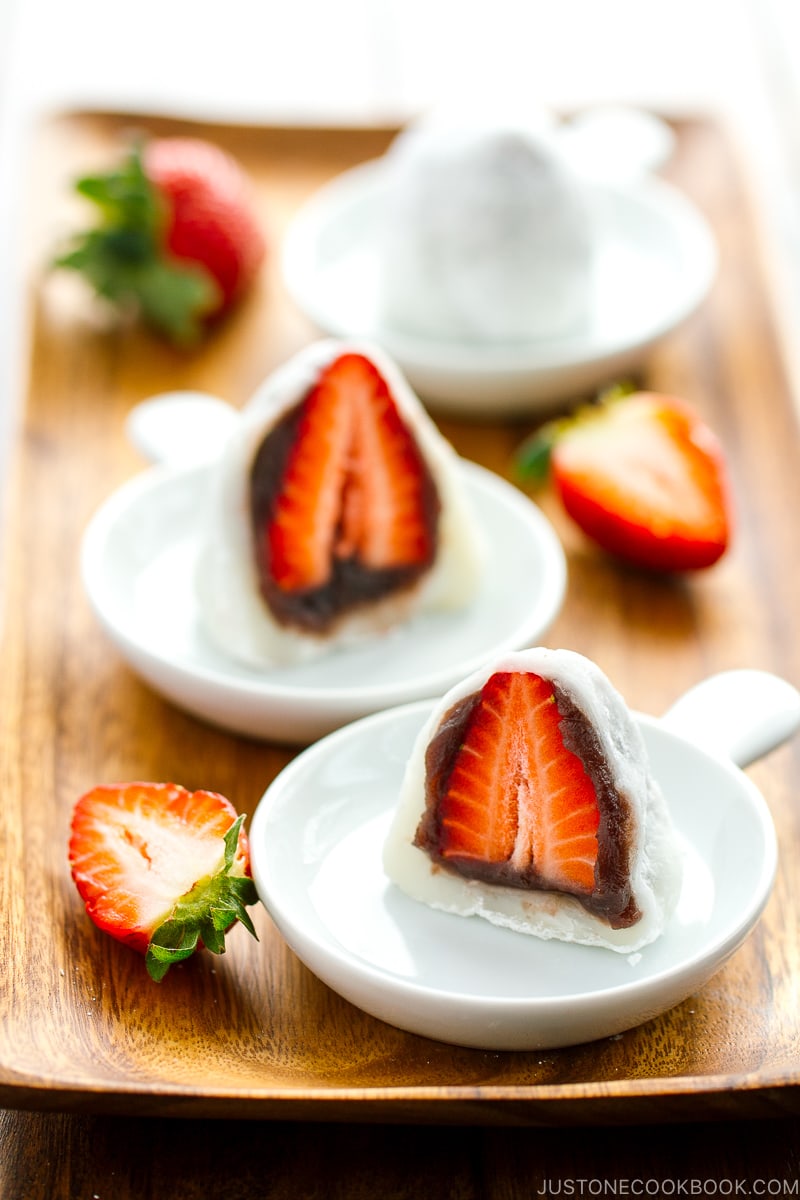
During the springtime, Japanese confectionery shops sell a seasonal daifuku, Strawberry Mochi (Ichigo Daifuku いちご大福), with a whole strawberry as the filling. The combination of fresh, soft mochi, sweet red bean paste, and a juicy, tart strawberry is a match made in heaven.
If you love juicy strawberries, sweet red bean paste, and chewy mochi, you will love this classic Japanese strawberry mochi dessert!
Table of Contents
What is Strawberry Mochi
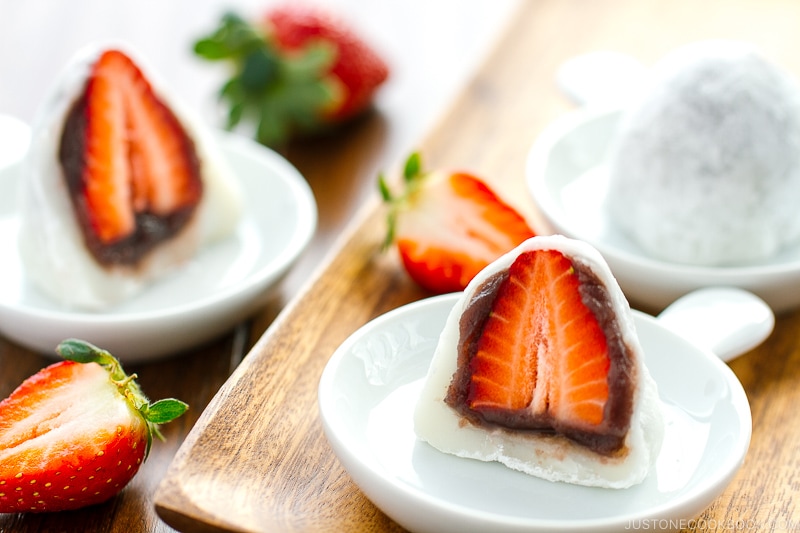
Strawberry mochi (or strawberry daifuku) is a modern rendition of a traditional Japanese sweet called daifuku (大福). Stuffed with sweet red bean paste, the original daifuku (see my recipe here) comes with the same soft and chewy mochi exterior with different stuffing.
Strawberry mochi was first created in the ’80s, so it’s considered a relatively new wagashi, like a traditional Japanese confectionery with a modern twist. Depending on regions and stores, some strawberry mochi have a red bean paste filling while others use Shiroan (white bean paste). Some mochi come with whipped cream and strawberry inside instead of red bean or white bean paste.
This seasonal mochi includes fresh strawberries, so it is only offered during the strawberry season in Japan, which falls between winter and spring.
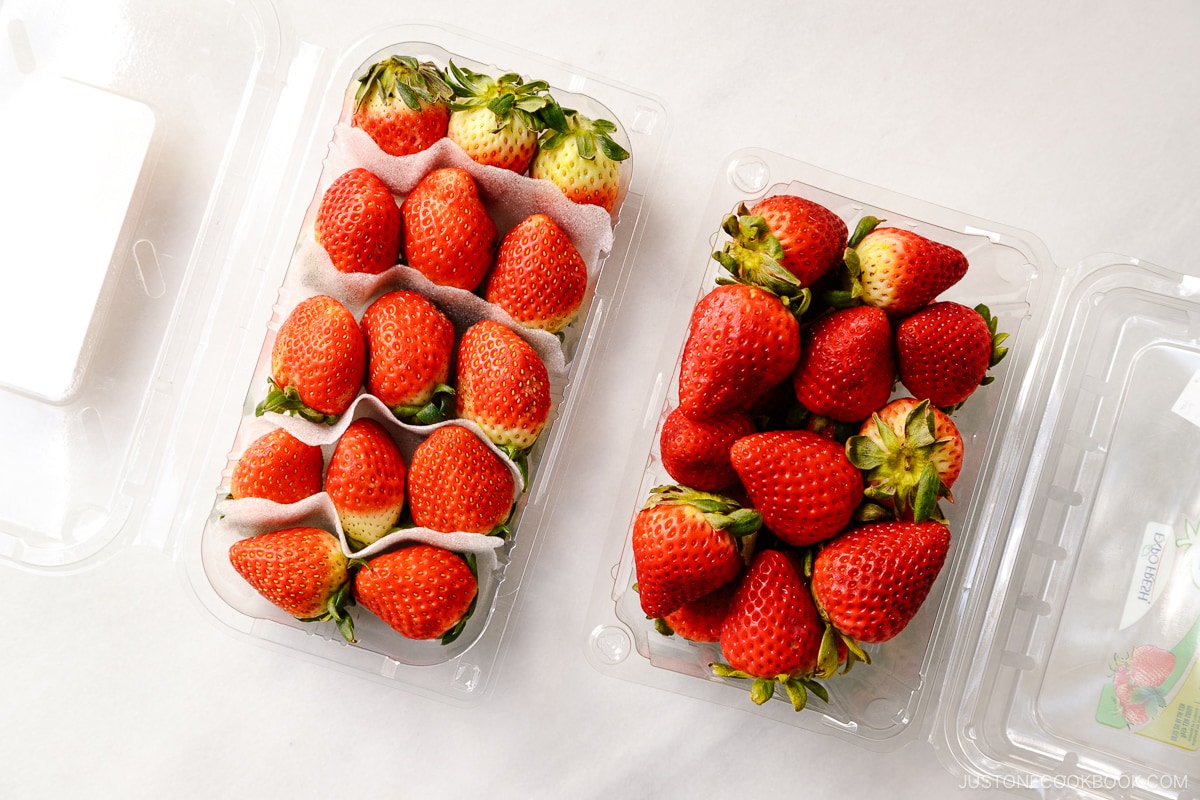
Ingredients for Strawberry Mochi
- Fresh strawberries – Go with organic and smaller-sized strawberries
- Sweet red bean paste (anko) – I used store-bought koshian; you can make my recipe for homemade Anko or Pressure Cooker Anko)
- Mochi skin (the outer shell): shiratamako (glutinous rice flour/sweet rice flour), sugar, and water
- Potato starch or cornstarch for dusting
How to Make Strawberry Mochi
Here’s a quick overview, but you can find my detailed step-by-step instructions in the Recipe Card below:
- Prepare the strawberry filling: Wrap each cleaned and dried strawberry with anko (red bean paste) ball.
- Make the mochi: Mix shiratamako with sugar and water, and cook the mixture in the microwave. Then, divide the mochi into equal pieces.
- Shape the daifuku: Cover your hands with some potato starch or cornstarch. Flatten and expand each mochi into a round or square. Begin shaping the daifuku by placing the anko-covered strawberry on top of it, with the tip pointing down. Now you are done. Serve and enjoy at room temperature!
How simple is that!
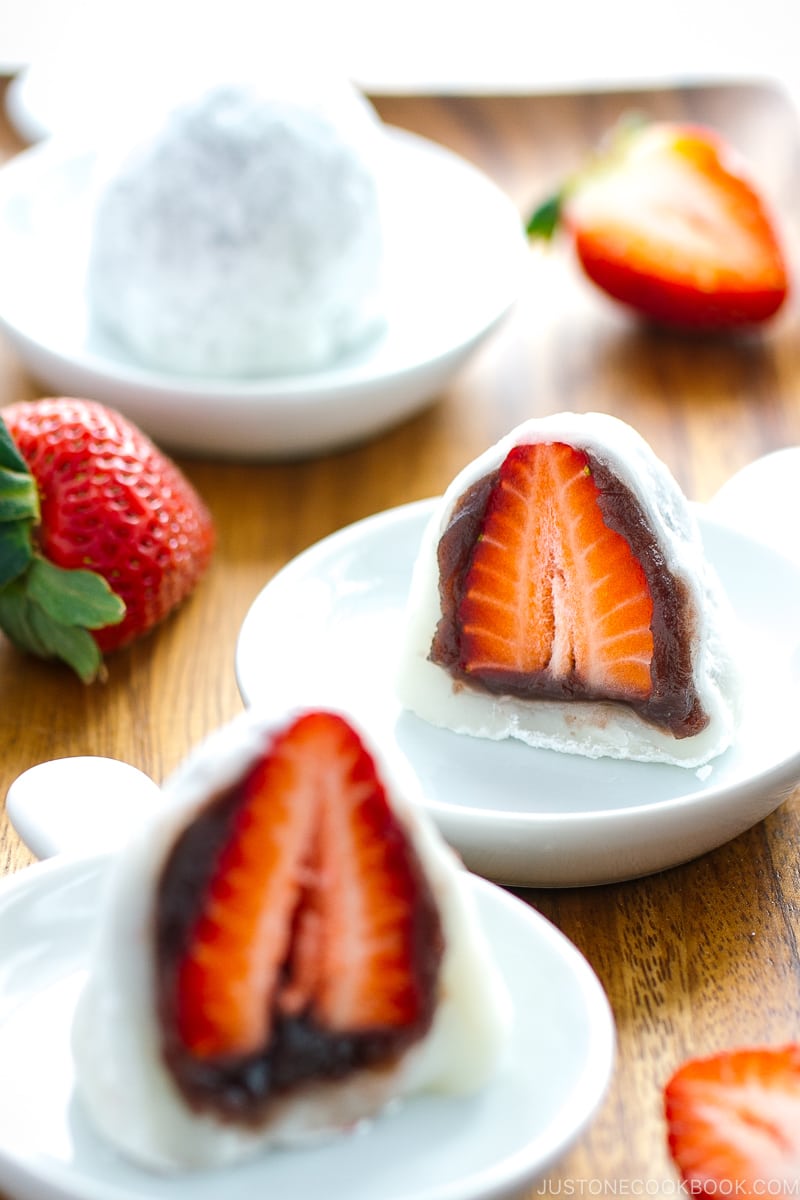
Tips for Making the Best Strawberry Daifuku
Making daifuku is very much like a craft. The process can be fun and meditative but don’t rush it. Here are a few simple things to follow for best looking mochi:
- Wash your hands and dry completely each time you wrap a strawberry with anko.
- Be careful not to stretch the mochi dough too thin. When working with mochi dough, be careful not to stretch it too thin to prevent tearing.
- Coat your fingers with enough potato starch or cornstarch when wrapping the strawberry anko with the mochi skin.
Storage Tips
Keep the leftovers in an airtight container and store it at room temperature. Do not put it in the refrigerator as the cold temperature makes the mochi hard. Consume within 2 days.
Perfect Spring Dessert to Make with Your Kid(s)
Sweet, elegant, and delicate, Strawberry Mochi is another delicious way to celebrate the season.
My daughter loves helping me wrap the sticky, elastic mochi around the berries when I make daifuku for them. It’s like working with edible play dough for her. Although her shaping skills still need improvement, she usually thinks her daifuku are the prettiest and tastiest. What can I say?
If you make my Strawberry Mochi recipe, I’d love to hear how it turns out in the comments below! You can also send me a picture on Instagram. Seeing your creations makes me happy!
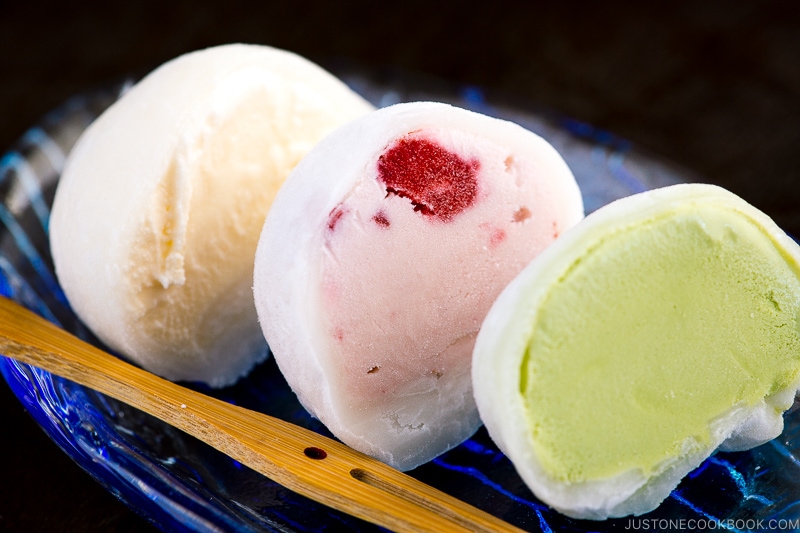
Other Mochi Desserts You’ll Enjoy
Wish to learn more about Japanese cooking? Sign up for our free newsletter to receive cooking tips & recipe updates! And stay in touch with me on Facebook, Pinterest, YouTube, and Instagram.
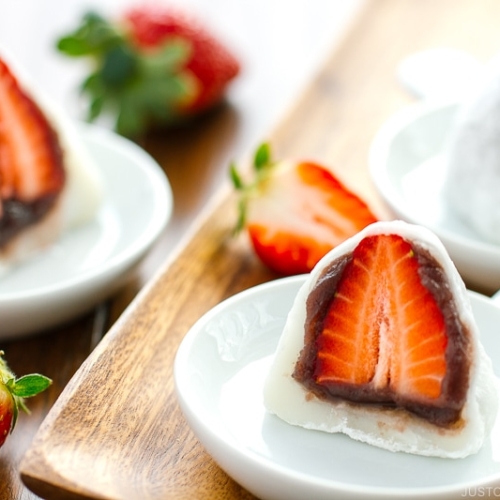
Strawberry Mochi (Ichigo Daifuku)
Ingredients
- 6 strawberries (smaller ones are easier to work with)
- 5.3 oz sweet red bean paste (anko) (I used store-bought koshian; you can make my recipe for homemade Anko or Pressure Cooker Anko)
- potato starch or cornstarch (for dusting)
For the Mochi Using a 100 g Shiratamako Package
- ¾ cup shiratamako (glutinous rice flour/sweet rice flour)
- 1½ Tbsp sugar
- 150 ml water (⅔ cup minus 2 tsp)
For the Mochi Using a 120 g Shiratamako Package
- 120 g shiratamako (glutinous rice flour/sweet rice flour) (1 cup minus 2 Tbsp)
- 2 Tbsp sugar
- ¾ cup water
Instructions
- Before You Start: If you want to make more than 6 pieces, I highly recommend you to work in batches. If you do not have a microwave, please see Notes for other options to cook the shiratamako.
To Prepare the Strawberries
- Rinse, dry, and hull 6 strawberries. Divide 5.3 oz sweet red bean paste (anko) and roll into 6 same-size balls. Anko gets sticky on your hands, so wash and completely dry your hands each time you make a ball.

- Wrap each strawberry with the anko from one ball. Leave the tip of the strawberry uncovered. Wash your hands and dry completely each time you wrap a strawberry with anko.

To Cook the Shiratamako
- In a medium microwave-safe glass bowl, mix the shiratamako and sugar with a whisk. For a 100 g bag, mix 100 g or ¾ cup shiratamako (glutinous rice flour/sweet rice flour) and 1½ Tbsp sugar. For a 120 g bag, mix 120 g shiratamako (glutinous rice flour/sweet rice flour) (or 1 cup minus 2 Tbsp) and 2 Tbsp sugar.

- Using a silicone spatula, slowly add the water in 3 parts—a total of 150 ml water (⅔ cup minus 2 tsp) for the 100 g shiratamako bag and ¾ cup water for the 120 g bag. Stir until the mixture has reached a thick consistency. Cover loosely with plastic wrap.

- First, microwave the mixture for 1 minute (for 1100W microwave). Mix well with a wet silicone spatula. The mixture is still whitish and floury.

- For a second time, microwave 1 minute again, and mix well with the wet silicone spatula. Now it starts to resemble mochi, but there are still some floury parts.

- For the last time, microwave only 30 seconds. Now the mochi mixture should look translucent.

- Sift the potato starch or cornstarch on the tray and put the mochi on top.

- With the silicone spatula or a kitchen scraper, fold the mochi in half one time so it won’t be as sticky. Then, divide into 6 equal pieces.

To Shape the Strawberry Daifuku
- Put some potato starch or cornstarch on your hands. Flatten and expand each mochi into a 3-inch (7.6-cm) round or square. Then, put the anko-covered strawberry on top of it, with the tip pointing down.

- Start gathering the mochi edges to cover the strawberry from all sides. Use your thumb to hold the gathered mochi on top.

- When all edges of the mochi meet at the top, twist and close the seam. Hold the mochi with both hands and form into a nice round shape. Place the daifuku seam side down on a plate with the strawberry tip pointing up. Repeat the process for the remaining mochi.

To Serve
- Serve at room temperature.

To Store
- Keep the leftovers in an airtight container and store at room temperature. Do not put in the refrigerator as the cold temperature makes the mochi hard. Consume within 2 days.
Notes
- Rice cooker: Put the ingredients in the bowl of the rice cooker and mix well. Cook for 10-12 minutes or until the mixture is translucent. Mix with silicon spatula at least 2 times during cooking.
- Steamer: Put the ingredients in a heatproof bowl that fits inside your steamer. Mix well and cover with a thin kitchen towel or heatproof plate. Cook for 10-12 minutes or until the mixture is translucent. Mix with silicon spatula at least 2 times during cooking.


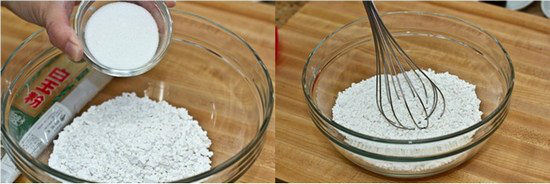


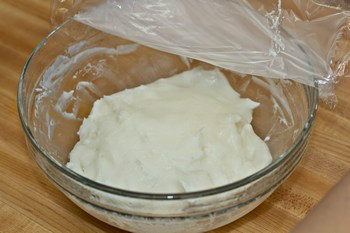
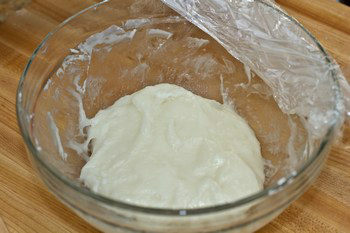
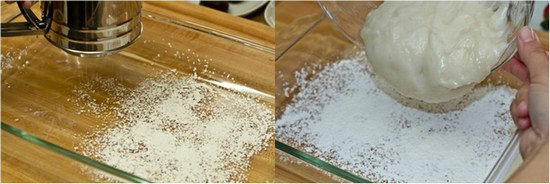
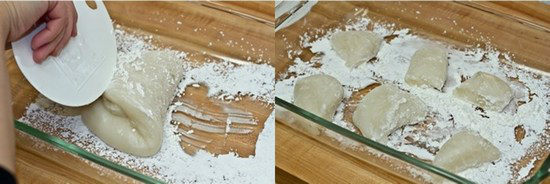
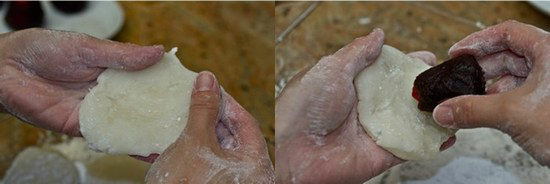














Hello! I’m trying to make these for a school event, but I want to serve them fresh. Is it possible to pre-make the mochi dough, store it in the fridge, and then re-heat it in the microwave right before I start wrapping the fruit the next day?
Hello, Tiffany. Thank you for reading Nami’s post and trying her recipe.
When you refrigerate mochi dough, it hardens and becomes chewier. If you’re shaping them the next day, re-heating may work, but you may need to add a little water to achieve the right texture.
Fabulous! Thank you for the recipe. It turned out just like we remembered from our trip to Japan. I made the anko from your recipe and it was perfect. One little tweak I made after the first batch was to enrobe the anko in the mochi and then slice the top and insert the strawberry at the end. This made it a little easier and it looked like the ones we loved so much on our travels. Thank you for the instructions!
Hi Michelle! We are glad to hear you enjoyed homemade Daifuku!
Thank you so much for trying Nami’s recipe and sharing your experience with us! 🫶🏻
hi! i have tried this recipe but the mochi skin rips apart..would you know why? thank you
Hello there, Jennifer! Thank you for trying Nami’s Daifuku recipe!
Your Daifuku skin was probably too thin. When flattening the mochi, please leave a little additional thickness.😉
We hope this helps!
[…] For sweets, we use it to make Mochi Ice Cream, Zenzai (Oshiruko), and Strawberry Daifuku. […]
Hello!
when you microwave the mochi flour mixture, do you leave the plastic wrap on or remove it prior to microwaving? I typically do not have plastic wrap on hand and usually avoid purchasing it, but if it’s a necessary element of this recipe I will pick some up. I have just ordered the anko and the shiratamako, and this will be my first time making mochi. Appreciate your feedback!
Hi Lydia! Thank you very much for reading Nami’s post and trying her recipe!
You can use a microwave-safe plastic hardcover or microwave-safe plate to cover the bowl instead of plastic wrap. You just need something to cover the bowl.
We hope this helps!
Hi! I just made your red bean paste recipe and am so happy with the result! I’m excited to use it to make this ichigo daifuku, but was wondering if it’s possible to halve the recipe? Would I have to keep the mochi mixture in the microwave for half the time as well?
Hi Lisandra, Thank you very much for trying Nami’s recipes!
Yes, you can halve this recipe. As for the cooking time in the microwave, try 10 seconds less from each step.
We hope this works well for you! Happy Cooking!
Hi Nami,
1. Is it necessary to leave the dough in the fridge for 15 mins before wrapping the filling ?
2. After freezing individually wrapped mochi, will thawing give them the soft consistency as when they were freshly made ?
3. What is the estimated weight of each wrap and filling ?
Thanks.
Hi Fran! Thank you very much for trying Nami’s recipe!
We hope these answers would be helpful!
1) You do not need to leave the dough in the fridge for this recipe.
2) After defrosting the individually wrapped Daifuku, the mochi will be soft as when they were freshly made. However, the Strawberry would get soft and more waterly, so some people enjoy the half-frozen Strawberry Mochi for the reason.
3) The Anko is 25g each. The mochi would be around 45~50g each. (Nami divided this recipe into 6 Daifuku.)
Thanks for this recipe! I had so much fun making it 🙂
Hi Celeste! Thank you very much for trying Nami’s recipe!
We are so happy to hear you enjoyed making Daifuku!☺️
Hi Nami,
I tried making this today, but the mochi was so sticky it won’t leave my hands and wrap around the strawberry. Do you have any suggestions? Do I need more cornstarch?
Hi Vivian, Thank you very much for trying Nami’s recipe!
It sounds like the Mochi did not have enough cornstarch or potato starch at steps 10 and 11.
We recommend using more cornstarch or potato starch to cover both sides of the mochi when you are flattening them, and don’t forget on your hands too. We hope this helps!
こんにちは! I am planning to make these for Easter in April, but my siblings don’t like anko :’) I was wondering if there was another filling you would suggest using that would be equally tasty so that they can enjoy this recipe as much as I do!
Hi Akiku, こんにちは!Thank you very much for trying this recipe!
How about Nama chocolate, custard cream, or ice cream inside the Daifuku? You may simply put fresh fruit too.
https://www.justonecookbook.com/nama-chocolate/
https://www.justonecookbook.com/green-tea-chocolate/
We hope this helps!
Dear Nami,
Can I use Mochiko if I can’t locate shiratamako? I would love to make this but haven’t had luck with that ingredient!
Hi Claire, The texture will be a little different, but you can use Mochiko. You can learn more about Mochiko vs. Shiratamako in this post: https://www.justonecookbook.com/mochiko/
We hope this helps!
question: instead of measuring the shiratamako/mochiko in cups/Tbsp, do you have a measurement by weight? For example, is the 100g of shiratamako = 3/4 cup of shiratamako?
thank you!
Hi a ishizaki, At the bottom of the ingredient list in the recipe card, please click “US Customary – Metric”. It will show you the Metric measurement. Thank you very much for trying this recipe!